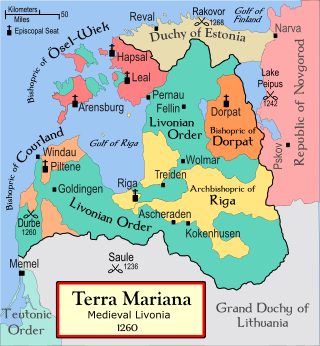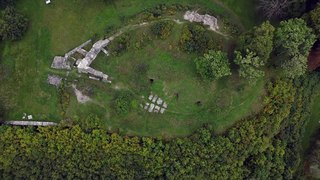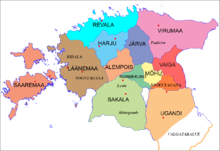The Northern Crusades or Baltic Crusades were Christian colonization and Christianization campaigns undertaken by Catholic Christian military orders and kingdoms, primarily against the pagan Baltic, Finnic and West Slavic peoples around the southern and eastern shores of the Baltic Sea, and to a lesser extent also against Orthodox Christian Slavs.

Lembitu was an ancient Estonian senior (elder) from Sakala County and military leader in the struggle against conquest of the Estonian lands by the German Livonian Brothers of the Sword at the beginning of the 13th century. He is the only Estonian pre-Crusade ruler, about whom some biographical information is known.

The Livonians, or Livs, are a Balto-Finnic people indigenous to northern and northwestern Latvia. Livonians historically spoke Livonian, a Uralic language closely related to Estonian and related to Finnish. The last person to have learned and spoken Livonian as a mother tongue, Grizelda Kristiņa, died in 2013, making Livonian a dormant language. As of 2010, there were approximately 30 people who had learned it as a second language.

Saint George's Night Uprising in 1343–1345 was an unsuccessful attempt by the indigenous Estonian population in the Duchy of Estonia, the Bishopric of Ösel-Wiek, and the insular territories of the State of the Teutonic Order to rid themselves of Danish and German rulers and landlords who had conquered the country in the 13th century during the Livonian Crusade; and to eradicate the non-indigenous Christian religion. After initial success the revolt was ended by the invasion of the Teutonic Order. In 1346, the Duchy of Estonia was sold for 19,000 Köln marks by the King of Denmark to the Teutonic Order. The shift of sovereignty from Denmark to the State of the Teutonic Order took place on November 1, 1346.

Lihula is a town in Lääneranna Parish, Pärnu County, Estonia.
Vyachko of Koknese, also Vetseke of Kokenhusen was the ruler of the Principality of Koknese in present-day Latvia, a vassal of Polotsk, who unsuccessfully tried to establish himself as a local ruler first in Latvia and then in Estonia, and fought against the expansionism of the Livonian Knights at the turn of the 13th century.
The Battle of Lihula or Battle of Leal was fought between invading Swedes and Estonians for the control of a castle in Lihula, Estonia in 1220. The exact date remains uncertain, though some historians suggest that the battle took place on August 8. The event is described in the Chronicle of Henry of Livonia and the Livonian Rhymed Chronicle.

Oeselians or Osilians is a historical name for the people who prior to the Northern Crusades in the 13th century lived in the Estonian island of Saaremaa (Ösel) — the Baltic Sea island was also referred as Oeselia or Osilia in written records dating from around that time. In Viking Age literature, the inhabitants were often included under the name "Vikings from Estonia". The earliest known use of the word in the (Latinised) form of "Oeselians" in writing was by Henry of Livonia in the 13th century. The inhabitants of Saaremaa (Ösel) are also mentioned in a number of historic written sources dating from the Estonian Viking Age.

The Livonian crusade refers to the various military Christianisation campaigns in medieval Livonia – in what is now Latvia and Estonia – during the Papal-sanctioned Northern Crusades in the 12–13th century. The Livonian crusade was conducted mostly by the Holy Roman Empire and the Kingdom of Denmark. It ended with the creation of Terra Mariana and the Danish duchy of Estonia. The lands on the eastern shores of the Baltic Sea were one of the last parts of Europe to be Christianised.
Battle of Ümera or Battle of Imera, recorded by Henry of Latvia was fought south of Valmiera, near the Gauja River in August or September 1210, during the Livonian Crusade between Crusaders and Estonians. The Estonians won the battle.
Battle of Otepää was a battle during the Livonian Crusade in 1217. The battle ended with a victory for the Estonians and Russians.

Nurmekund was a small independent country on the north coast of Lake Võrtsjärv in Central Estonia, bordered by Sakala, Alempois, Järvamaa, Mõhu, and Ugandi. Nurmekund had an area of approximately 600 hides.

Alempois was a small independent landlocked county in ancient Estonia, bordered by Harjumaa, Järvamaa, Nurmekund, Sakala, and Läänemaa. Alempois had an area of approximately 400 hides.

Soopoolitse was a small landlocked ancient Estonian county in the eastern part of the territory of Estonia.

Mõhu was a small landlocked ancient Estonian county in the central part of the territory of Estonia. It was later conquered by the Teutonic Order during the Estonian Crusade.

Vaiga was a small landlocked ancient Estonian county in the eastern part of the territory of Estonia. It territory now belongs to the eastern part of Jõgeva County.
The Battle of Cēsis was fought between native Estonian forces and the Germanic knights and their allies during the Livonian Crusade.
The siege of Tartu took place in 1224 and resulted in the fall of the last major center of Estonian resistance in the mainland provinces to the Christian conquest of Estonia.

Terra Mariana was the official name for Medieval Livonia or Old Livonia. It was formed in the aftermath of the Livonian Crusade, and its territories were composed of present-day Estonia and Latvia. It was established on 2 February 1207, as a principality of the Holy Roman Empire, but lost this status in 1215 when Pope Innocent III proclaimed it as directly subject to the Holy See.








